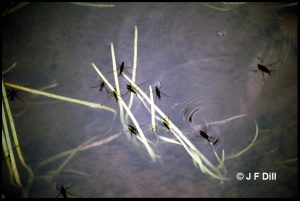Water Striders

Water striders (Family: Gerridae) are rather peculiar-looking insects that are part predator and part scavenger. Many people believe they resemble big mosquitoes or spiders walking on water. They are also called water spiders, water skeeters, or pond skaters. Taking advantage of the surface tension of water, they truly can ‘skate’ on it, darting this way and that way with impressive speed and quickness (upwards of 3 feet per second!).
You can find water striders on the surface of ponds, slow-moving streams or rivers, vernal pools, marshes, and virtually any other quiet waters. Since some species possess wings and can fly, it is not uncommon to find some in an outdoor swimming pool. They often gather in pairs or groups wherever they are found. One of the interesting things they do is to make ripples on the water surface in order to attract mates. They also utilize their ripple-detection ability, coupled with excellent eyesight, to hone in on potential prey that may have accidentally fallen into the water.
 Water striders have dark brown or black bodies that are flat and long, growing to just over 1/2-inch in length, with three pairs of legs that each have a unique function. Their first pair of legs are very short and are used to attack and hold onto their prey. Their long middle and back pairs of legs are used for locomotion; the middle pair pushes them along while the back pair steers. The long and thin design of those same four legs allows the weight of their body to be evenly distributed over a very large surface area, which thereby helps them to stand on the water. In addition, their feet/tarsi are covered with thousands of tiny, water-repellent hairs that can trap and hold onto small bubbles of air that further helps to keep them aloft on the water’s surface. These hydrophobic hairs and air bubbles also enable the insects to float back to the surface should a wave or other outside force cause them to become submerged. Sometimes they deliberately go underwater in order to escape a predator or other perceived threat, then pop back up to the surface again once they feel the danger has passed.
Water striders have dark brown or black bodies that are flat and long, growing to just over 1/2-inch in length, with three pairs of legs that each have a unique function. Their first pair of legs are very short and are used to attack and hold onto their prey. Their long middle and back pairs of legs are used for locomotion; the middle pair pushes them along while the back pair steers. The long and thin design of those same four legs allows the weight of their body to be evenly distributed over a very large surface area, which thereby helps them to stand on the water. In addition, their feet/tarsi are covered with thousands of tiny, water-repellent hairs that can trap and hold onto small bubbles of air that further helps to keep them aloft on the water’s surface. These hydrophobic hairs and air bubbles also enable the insects to float back to the surface should a wave or other outside force cause them to become submerged. Sometimes they deliberately go underwater in order to escape a predator or other perceived threat, then pop back up to the surface again once they feel the danger has passed.
